Marvelous Mozzani!
The Incredible Harp Guitars of Luigi Mozzani
by Gregg Miner
Marvelous Mozzani!
The Incredible Harp Guitars of Luigi Mozzani
by Gregg Miner
Chapter 3: Mozzani's Inspiration
|
If there was anyone more outrageous in guitar design than Luigi Mozzani, it was Freidrich Schenk (or Schenck), of Vienna. I have yet to find much information on Schenk - hopefully, my German counterparts and others in Europe will continue to piece together information on him. It's interesting that Mozzani's distinctive harp guitar designs are so renowned, and yet it was Schenk who created the original, even more spectacular, versions - and he did it apparently out of thin air! Schenk seems to have been the first in history to come up with both the single hollow arm form termed "bogenguitare" and a continuous double arm ("lyra") form of harp guitar (when Mozzani created his versions, he referred to both as "chitarra-lyra" [lyre-guitars]). The actual years of Schenk's production remain unknown to me - dates I've seen attributed to these instruments range from 1830-1870. Many other makers copied the Schenk designs some decades later. About 1909, Mozzani discovered them as well, and rather than simply duplicate them, he essentially re-invented them with new novel features. NOTE 2
|
| As novel and unusual as
Schenk's designs were,
they apparently were popular and well-regarded enough to spawn
many imitations and copies - both contemporary with his time, and
even decades later, contemporary with Mozzani's new variants.
|

|
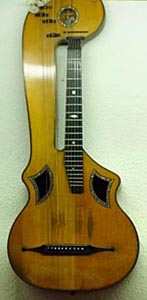
|
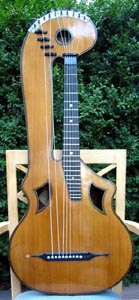
|
Lagler, 1852 |
Hans Raab |
Karl Müller, 1904, Augsburg, Bavaria |
|
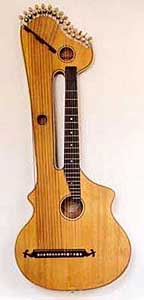 |
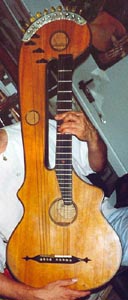 |
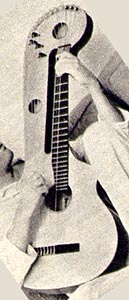 |
|
|
Felix Seboldt, Munich, 1925 |
Seboldt | Seboldt |
Max
Klein, 1930 (suspected, not verified) |
| NOTE 2. I've never seen discussed exactly which specimens of Schenk's instruments Mozzani saw. Only the general term "chitarra-lyra" is mentioned. Presumably Mozzani saw both main Schenk types, the dual-arm "lyra" form and the one-arm "bogenguitare" form (in both "hourglass" and "wappen" shapes) - as he made his own versions of both. |
|
Credits/Sources: See Table of Contents
|
|
|
|
All Site Contents Copyright © Gregg Miner, 2004,2005,2006,2007,2008,2009,2010,2011. All Rights Reserved. Copyright and Fair Use of material and use of images: See Copyright and Fair Use policy. |